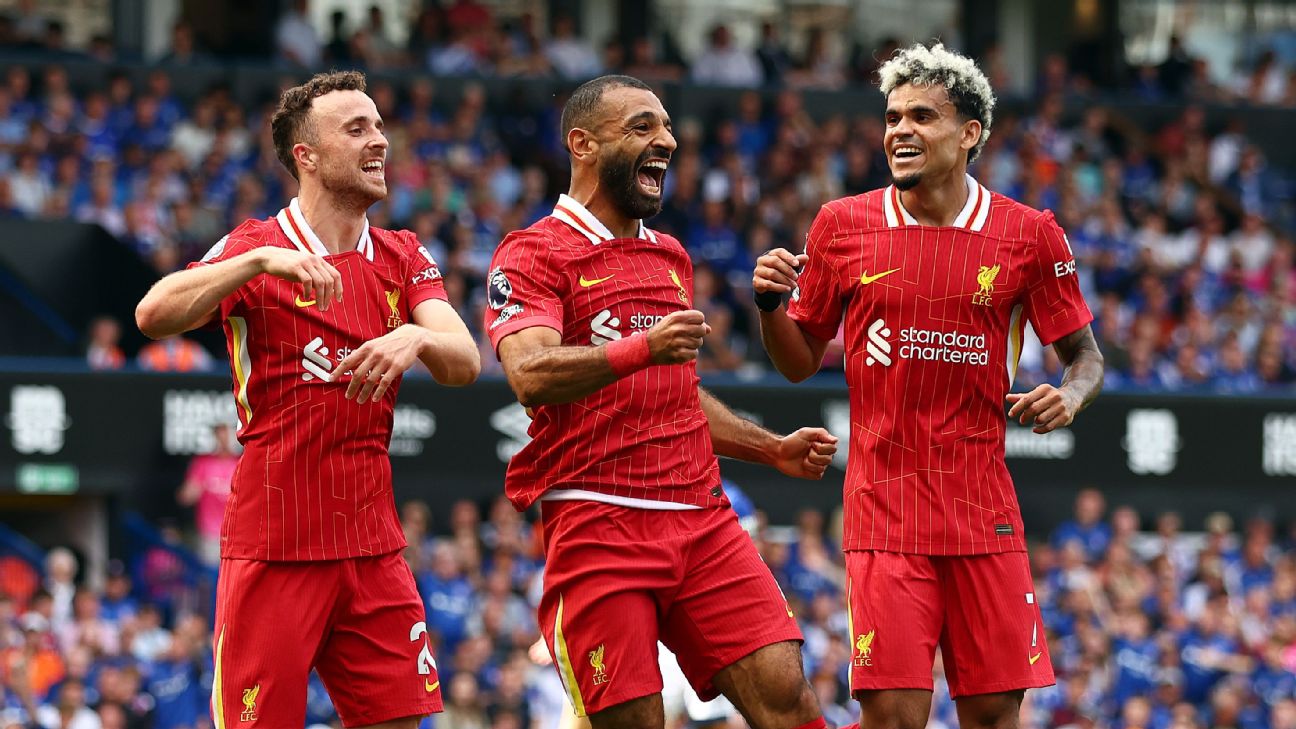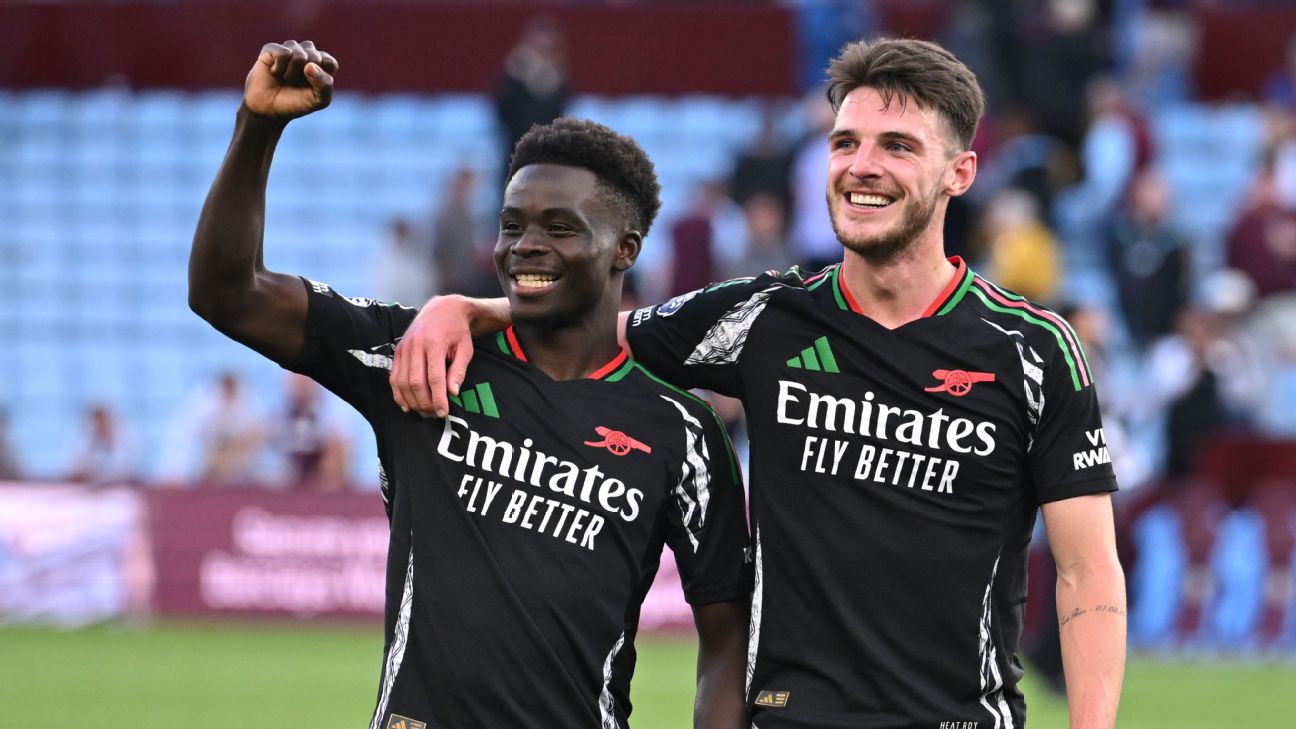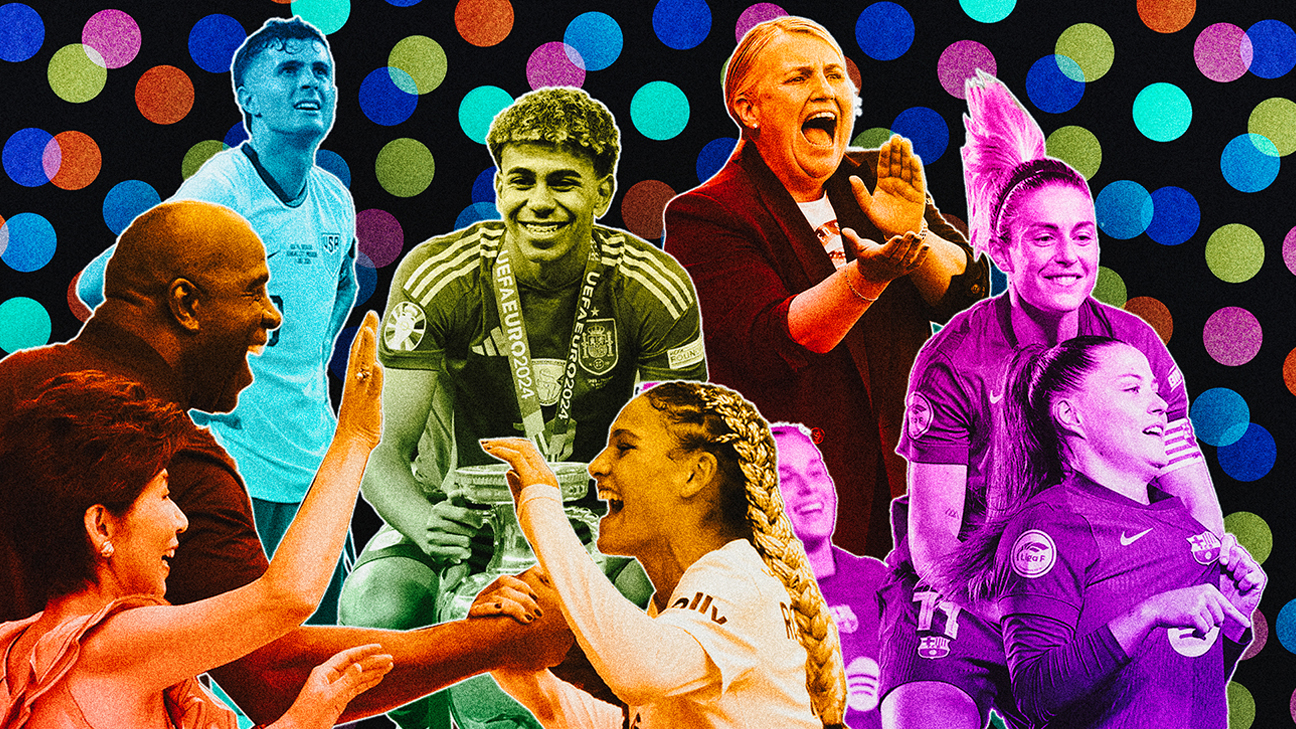We’re already back!
You might think three games is too early to readjust our preseason Premier League rankings, but you are wrong for two reasons: (1) The transfer window ended after the season started, and (2) the now-ended international break gave us both time to pause and reflect on everything we’re already ready to admit that we got wrong.
While there hasn’t been a ton of movement in our power rankings, the three matches of play and the slew of personnel moves at the end of the summer window did give us enough information to make a handful of notable adjustments to how we view the landscape of the league.
As always, we have each ranked all 20 teams, 1-20, and then combined their rankings to produce one master ranking. The criteria: who we think would win a match if any of these teams played each other on a neutral field in the near future.
The updated rankings are below, followed by some analysis of the most notable changes (or non-changes) from the previous edition of our rankings.
The updated Premier League team rankings
September and August’s rankings — the combination of Bill and Ryan’s individual rankings — are listed along with the new adjustments, plus each team’s present points totals on the Premier League table and goal differential:
Arsenal and Liverpool: trading places
For the most part, the teams we expected to look like the best in the Premier League have done nothing to dissuade us through three matchdays. Manchester City and Liverpool are both 3-for-3 in the wins department with identical plus-7 goal differentials, and while Arsenal dropped points at home to Brighton, (a) Brighton are good and (b) Arsenal were in complete control until Declan Rice’s red card early in the second half.
It’s hard not to feel a twinge of unease about the Gunners, though, if only because last year’s biggest weakness doesn’t appear to have been solved. Arsenal played with an abundance of caution in 2023-24, especially in the biggest matches of the season: Three matches against Manchester City produced a total of three goals, and three of their four Champions League knockout matches (two against Porto, two against Bayern Munich) finished with 1-0 scores. This approach nearly won them the Premier League, of course, but compared to the other current Premier League giants, they didn’t create nearly as many high-level scoring chances.
As we said in our season preview:
“They generate plenty of chances. The problem is not many of them are high-quality. […] There’s a fascinating question of the push-and-pull between Arsenal’s defense and its attack: Is the defense as good as it is because there’s a limit on how good the attack can be? Or can the defense maintain its level while the attack potentially improves? If it’s the latter, Arsenal will win the league.”
Three matches into 2024-25, Arsenal have not yet proven any more capable of winning the shot quality battle.

Arsenal have attempted both fewer shots and fewer great shots than their opponents thus far, and their shots have been worth fewer expected goals, or xG.
• Shot attempts: Manchester City 48, Liverpool 48, Arsenal 38
• Shots allowed: City 21, Liverpool 23, Arsenal 42
• Shot attempts worth at least 0.33 xG: City 7, Liverpool 6, Arsenal 2
• Shots allowed worth at least 0.33 xG: City 1, Liverpool 3, Arsenal 3
Goalkeeper David Raya was heroic against Aston Villa and has done excellent work in taking on 10 shots on goal, worth 1.9 post-shot xG (which is measured by where the shot was placed on goal) and allowing just one goal. But you probably aren’t going to win the league when you’re not winning the shot quality battle.
Arsenal currently rank 15th in xG per shot in attack. If Bukayo Saka or Kai Havertz aren’t creating something exciting, no one is. Saka and Havertz have attempted 18 of Arsenal’s 38 shots and created 2.9 of their 4.3 cumulative xG.
Saka alone has three of the Gunners’ four assists and seven of their 17 shots on goal. He’s made three of their eight successful 1v1s in the box, and he’s been responsible for two of their three fouls drawn in the attacking third. Hell, he even leads the team in ball recoveries. He’s just getting better and better, but if the plan in big matches is “play paranoid and hope Saka or Havertz has a moment of magic,” that might not be enough.
New central-midfield acquisition Mikel Merino is a solid attacker for his position, and it can’t hurt that winger Raheem Sterling fell into Arsenal’s lap when Chelsea elected to pay him to play for someone else. But Arsenal have not yet affirmatively answered the biggest question they faced.
Liverpool, on the other hand, have done that and then some.
New manager Arne Slot isn’t deploying the same hair-on-fire style as predecessor Jurgen Klopp, but Liverpool have played with patience and control, and they’ve been as dominant as any team in the league. They were perhaps fortunate to beat Manchester United 3-0 in their last game before the break — the xG differential from that match (+0.4) suggested something closer — but they still have both the league’s best goal differential (tied with City) and best xG differential.
The Reds attempting the highest percentage of shots in the box (81.3%), and their xG-per-shot margin is the league’s best as well. They’re balancing strong buildup play (20 buildup attacks, second in the league) with strong transition play (fourth in the league in xG margin on counterattacks), and even with Slot having no idea what to do with forward Darwin Núñez, Mohamed Salah and Luis Díaz have combined for six goals and four assists up front.
Liverpool look the part of a challenger, enough to pass our preseason league co-favorites into second on this list. — Connelly
Can Brighton finish fourth?
One of the truisms among analytically minded soccer watchers is that the transfer market is a fool’s game. As much as you can avoid it, you should. That is, from the buying perspective. As Brighton have shown since professional sports bettor Tony Bloom took over the club, the transfer market is a seller’s market.
It’s hard for a smart club to take advantage of a dumb club when trying to acquire a player; you’re basically trying to convince a club that one of their best players is worth less of a transfer fee than you actually think. But in the other direction? It’s quite easy to convince a richer club that your best players are better than they actually are. See: Chelsea exchanging €180 million with Brighton to acquire Marc Cucurella and Moisés Caicedo.
Now, I’m not saying it’s easy to be Brighton, but it’s certainly easier to be that version of Brighton. That version is the one that exploits the over-eagerness and inefficiencies of the biggest clubs in the world and then uses the Moises Caicedo money to acquire 10 more potential Moises Caicedos with a global, data-driven scouting approach.
But there’s a limit to that model. And that limit is occasionally flirting with a top-four slot, but usually finishing somewhere between seventh and 10th because you’d immediately move on from the players who helped you flirt for fourth.
This summer, though, Brighton decided to go for it. They’ve exposed themselves as a big fish, risking exploitation from a bunch of smaller teams that want to do to Brighton what Brighton have done to everyone else.
Across the summer transfer window, Brighton’s net spend (transfer profit minus transfer expenditure) was minus- €182.9 million — the biggest (or smallest, rather) number in the entire Premier League. There were still the little nibbles for promising teenagers in little-known leagues, but they also brought in six different players for €30 million or more. For a club of Brighton’s size, each move represents about 13% of their revenue — or less, comparatively, than what Tottenham laid out for Dominic Solanke, the league’s most expensive transfer of the summer.
For at least a summer, then, Brighton shifted from a model of low risk-high reward to one of high risk-high reward. If any of these players don’t become starters, the move will be a failure.
So far, only one of Brighton’s summer signings, right winger Yankuba Minteh from Newcastle, has started every game. And so far, they’ve been one of the best teams in the league — despite that and despite playing, theoretically, one of the toughest opening schedules in the league.
Per what I’m calling “adjusted goal rating” — a blend of 70% xG and 30% goals that even has some predictive power after only three matches — they’ve been a top-four team through three matches:
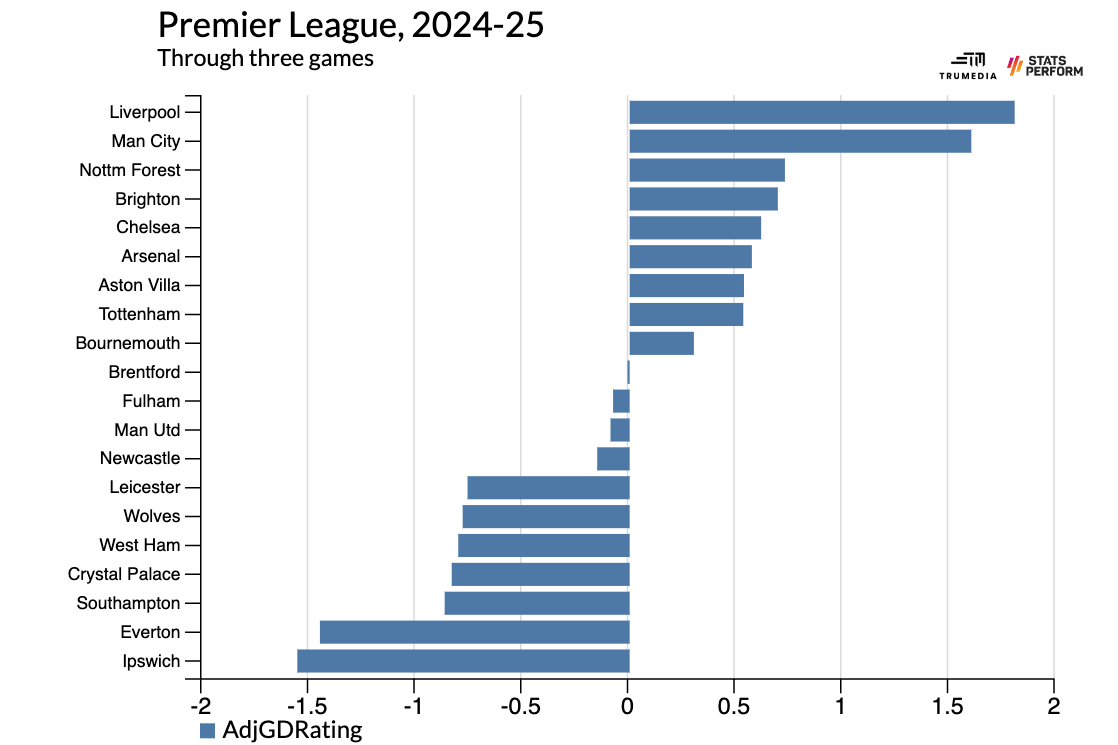
They’ve benefitted from red cards in two of their games already, but the betting markets know that, and Brighton’s final season points projection has already jumped up by eight points compared to where it was before the season started.
And the thing is, there’s still so much potential upside that we haven’t even seen yet. Their 31-year-old manager Fabian Hurzeler could continue to get better. Their two best prospects, Julio Enciso and Evan Ferguson, have played fewer than 20 combined minutes so far this season. And the non-Minteh big signings from this summer have still combined for only one start.
If Brighton maintain the current squad-usage profile they’ve shown from the first three matches, they’re not a top-four team. I’m sorry — Danny Welbeck and James Milner have both started every game! But if they’re able to integrate a few more of the summer signings and both Enciso and Ferguson start to contribute again? Then they absolutely could be playing in the Champions League next season. — O’Hanlon
What the heck is Newcastle trying to achieve?
Coming into the season, I picked Newcastle to finish fourth.
I tabbed Alexander Isak as a likely breakout star. I figured they wouldn’t be as injured as they were last season, thanks to not being in the Champions League. I assumed their performance level would fall somewhere between last year and the year prior, when they were genuinely one of the best teams in the league. And I also figured that their performance last season was better than most people realized — they finished last year with the fourth-best goal differential in England and scored just one fewer goal than Liverpool.
At the same time, it seemed like … they were just banking on all of this regression, too?
Rather than behaving like a team owned by a sovereign wealth fund this past summer, they let two of their best young players, Yankuba Minteh and Elliot Anderson, go to Brighton and Nottingham Forest. And the only signings they made were an already agreed move for Chelsea fullback Lewis Hall, an accounting shenanigans swap for backup goalkeeper Odisseas Vlachodimos from Forest, a tiny €11.6 million deal for backup striker William Osula from Sheffield United and a free agent move for Bournemouth center back Lloyd Kelly.
Much of this was driven by the tightening of the Premier League’s profit and sustainability regulations, but this is technically the richest sports team on the planet! As we saw with Brighton, smart teams spend money when they’re able to spend money.
Although Newcastle have seven points from their first three games, they have not been good at all. Seven points is quite literally the absolute maximum return from Newcastle’s plus-2 goal differential. And by the aforementioned adjusted-goal rating, they’ve been even worse than that — down at minus-0.15 per game, just the 13th-best mark in the league.
Even though they’ve banked a solid point total thus far, including a win over Tottenham, a direct top-four rival, their betting market projection has actually dropped by four points since the start of the season.
Now, there has been some weirdness to Newcastle’s first three matches. They played down a man for 70 minutes against Southampton in the opener, and despite getting drastically outshot by Tottenham, they created the better chances against Ange Postecoglou’s side. But a top-four team shouldn’t get run off the field at home against Southampton — even when you’re a man down — and that’s what happened, save for the shots not ending up in the net for Saints.
In the second match, they were genuinely outplayed by Bournemouth. And although they created better opportunities than Spurs, they still let them live inside their own penalty area.
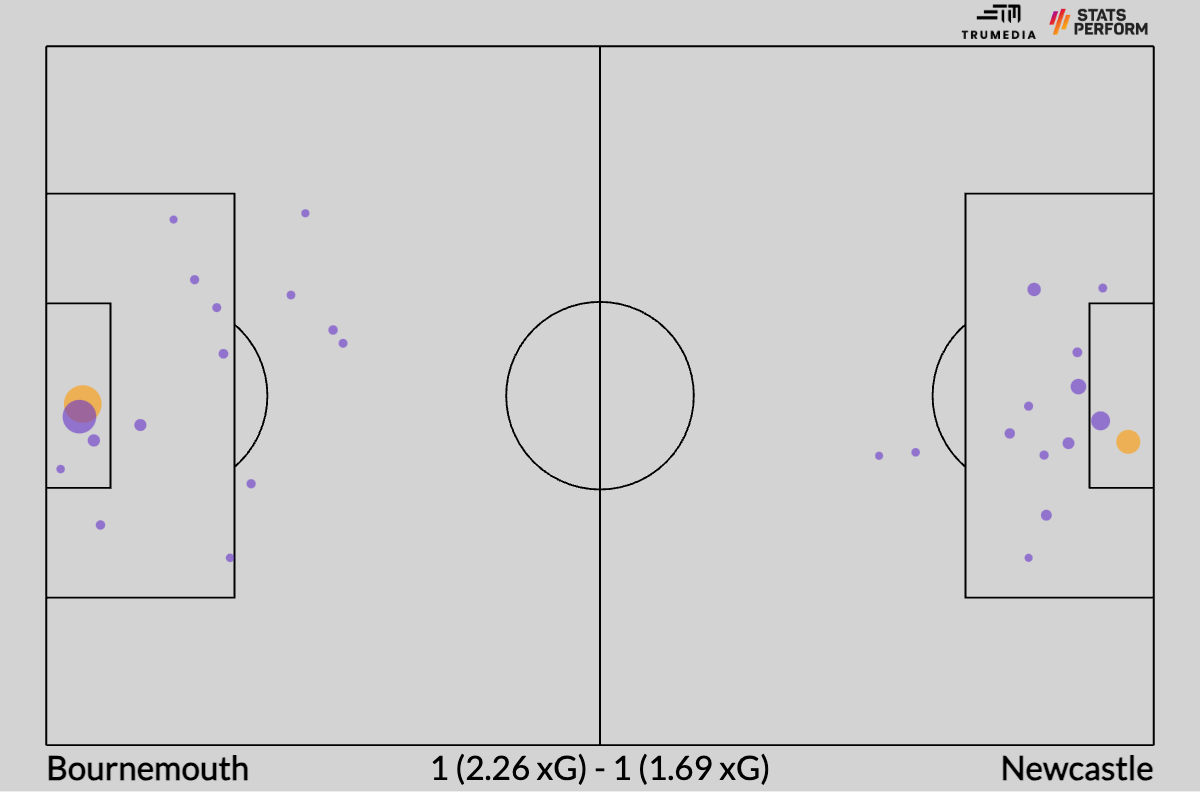
Perhaps most disconcerting is that the defense continues to be awful. They were one of the best defensive teams in the world two years ago, but then their strength became their weakness midway through last season as injuries seemed to crater their ability to suppress chances. And through three games this year, they’ve allowed 125 touches inside their own penalty area — by far the most in the league. None of the other theoretical contenders for fourth place have even allowed 90.
What a difference a year makes. At this time last season, Eddie Howe and Newcastle were on a sped-up timeline, gearing up for their first Champions League appearance in 20 years, equipped with more money than God, ready to establish themselves as one of the best teams in the world. Today, they seem stuck, somewhere slightly above midtable mediocrity. — O’Hanlon
Last year’s point deduction duo are heading in opposite directions
The bottom of the Premier League has taken shape about as expected. The three promoted teams (Leicester City, Ipswich Town and Southampton) have seven losses and two draws in their first nine combined matches. The three lowest-ranked incumbents in our preseason power rankings (Wolves, Fulham and West Ham) have just eight combined points.
If there are surprises, they have come from the two teams who suffered point deductions last season and found themselves in relegation scraps because of it. One (Nottingham Forest) has zero losses, and the other (Everton) has zero points. Both of these teams featured in August’s early season overreactions piece.
Everton’s first two matches produced one of the worst goal differentials in recent memory, and while their third match went much better for 85 minutes, they still turned a 2-0 lead into a 3-2 loss to Bournemouth.
Luis Miguel Echegaray and Janusz Michallik debate whether this is the year Everton will get relegated after their 4-0 defeat to Tottenham Hotspur.
It’s hard to find anything Everton are actually good at thus far. This being a Sean Dyche team, they are of course near the bottom of the league in any passing- or possession-related stats: 19th in possession rate (38.5%), 19th in pass completion rate (75.3%), 18th in progressive carries (122), 15th in progressive passes (103).
But they’re also bad at the things Dyche teams are supposed to be good at. While they have the sixth most counterattack attempts in the league (39), those attempts have produced just one shot (16th) worth 0.05 xG (0.05); meanwhile, their opponents have somehow created shots worth 1.4 xG from counters (18th) despite having most of the ball. Only Crystal Palace have a worse xG differential from counters than Everton, and Everton are supposedly a counterattacking team!
The Bournemouth match was easily their best of the season, and it was also the most wide open. Everton attempted 18 shots to Bournemouth’s 17 and found opportunities in the box, but despite Everton playing with the lead (and, again, being a Dyche team), all three of Bournemouth’s goals (in the 87th, 90+2 and 90+6 minutes) were shockingly easy, with crosses finding unmarked attackers in the box less than six meters from goal.
Everton have no idea what they’re good at right now (if anything), and they play at Aston Villa this weekend. They play at Leicester City on Sept. 21 and host Palace on Sept. 28 — it’s too early to talk about “must-win” games, but with the funk that has long followed Everton around due to their disastrous ownership situation, it definitely feels like they need points from those games to prevent the relegation vibes from growing absolutely toxic.
Everton are celebrating the 40th anniversary of their last league title (and their European Cup Winners’ Cup win) this season — they were one of the original clubs that pushed for the creation of the Premier League — but in the past 40 years they’ve never felt further away from prominence.
The vibes are 180 degrees different for another long-ago power. Nottingham Forest haven’t finished in the Premier League’s top 10 since 1995-96, but it’s not entirely outlandish to think that streak might end this season. Forest are unbeaten through three EPL matches for the first time since August 1995; they sandwiched a 1-0 win over Southampton with 1-1 draws against Wolves and Bournemouth, and their fundamental stats — third in xG differential, first in shot attempts and shots on goal, first in xG allowed per shot — are sound.
Of course, your numbers should be sound when, according to Opta’s power ratings, you’ve played the weakest set of opponents to date.
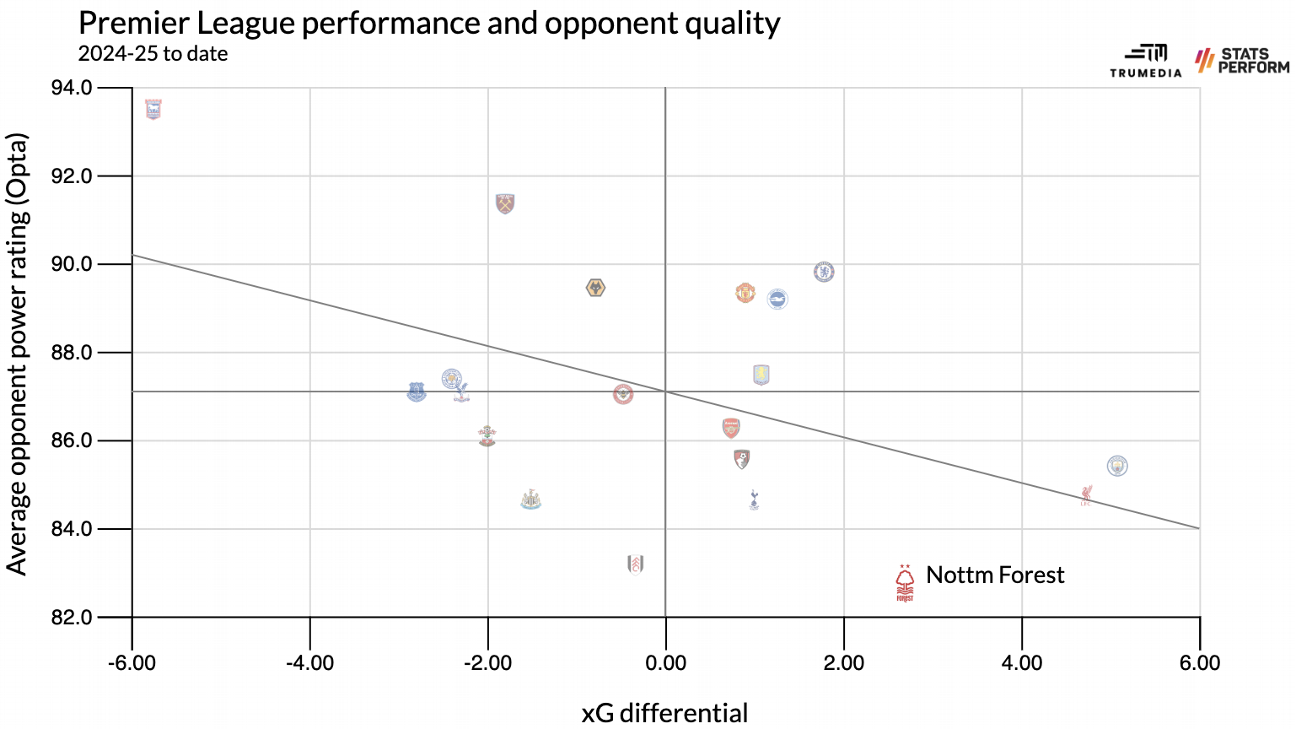
It certainly says something that Forest have fared better than teams with similar schedule strengths — Fulham and Spurs have produced fewer points and far worse xG differentials against the second and third weakest schedules — but obviously there’s plenty of work left to do.
Still, manager Nuno Espirito Santo has the personnel he needs to deploy his counterattacking style. Center-backs Murillo and Nikola Milenkovic are sound, fullbacks Neco Williams and Ola Aina have raised their respective games and the attacking combination of Morgan Gibbs-White (nine chances created) and Chris Wood (two goals) has done just enough damage up front.
Holding onto leads has been an issue — they’ve gone up 1-0 in all three matches but won only one — but this is still an optimistic time for the two-time European Cup champions. — Connelly
